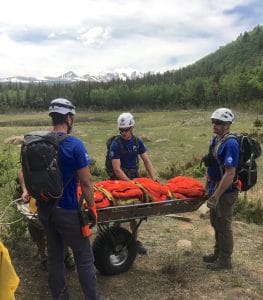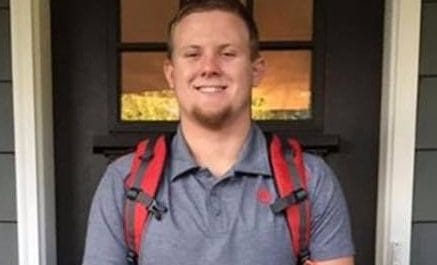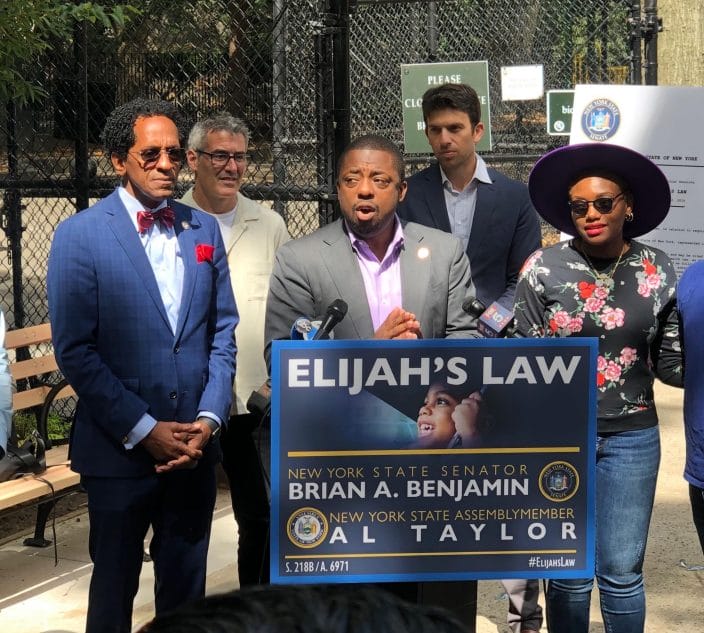 Trail carry portion of the evacuation. Photo: RMRG
Trail carry portion of the evacuation. Photo: RMRG It was quite the ordeal for the fortunate young teen and his 14 rescuers. The four-hour rescue effort involved belaying the teen’s stretcher down 50 feet and then trail-carrying him a mile to an ATV. The ATV then traveled three miles to reach an ambulance.
On the morning of July 4, 2019, the Scout, whom the Boulder County Sheriff’s Office described as a “juvenile teenager,” ate food containing sunflower seeds. He began to experience severe anaphylaxis at about 9:30 a.m. Within three minutes, Scout leaders had administered epinephrine to the boy.
At 10:15, the sheriff’s office was notified, and the Boulder Communications Center dispatched rescuers to the Beaver Reservoir area. This is a rugged, remote area about 30 miles northwest of Boulder. Two Scouts from the troop met members of the Rocky Mountain Rescue Group (RMRG) and the Indian Peaks Fire Protection District, along with paramedics. The Scouts led them to the boy’s location on the trail.
Carrie Haverfield, a spokesperson for the sheriff’s office, spoke of a “concerted effort” to coordinate the Scout’s rescue with RMRG. She describes the latter as “an amazing” all-volunteer, nonprofit group that gets involved in technical search-and-rescue operations.
Scout Rescue: 50-Foot Belay, Trail Carry
Drew Hildner, who is both a member of RMRG and the rescue group’s information officer, told Allergic Living that quick administration of epinephrine was critical. This was especially the case given the challenges of the terrain and the rescue that lay ahead.
Hildner said Scout leaders used an expired EpiPen “to good effect” on the teen with a known sunflower allergy. (It’s not clear if the injector was the teen’s own.) Then “a few more rounds of epi were provided during the rescue,” along with Benadryl. Hildner said his airway “was not intubated, but a chopper was initially on standby.”
The RMRG team included two emergency department doctors and several EMT-qualified members. The Scout’s rescue involved what Hildner called a “scree” evacuation. They belayed the teen in a stretcher from an anchor with rope for 50 feet, to control the speed of descent down the steep, loose hillside.
The rescuers then carried the stretcher along a trail for a mile to an ATV, which drove him along a 4WD road to the ambulance. The teen remained conscious throughout the eventful situation, and recovered in hospital.
Stressing the urgency of the situation, Hildner said: “In the wilderness, most often the best treatment is rapid evacuation. We can’t carry a whole ambulance or ED into the field with us (though we always field with airways and oxygen).”
Scout Rescue: Importance of Wilderness Prep
The reason for the delay between the Scouts giving the auto-injection and the call to the sheriff’s office isn’t clear. But Haverfield did raise a good point to consider: the lack of cell service in some areas. For those in similar circumstances, areas like Boulder County do let you text “911” if you can’t make contact by cell – because texts have lesser bandwidth, she explained.
RMRG’s Hildner shared the importance of allergy preparedness, especially in the wilderness where rescuers may face challenging terrain. “Generally, the same allergy precautions hold true in the outdoors/wilderness, but are even more important to follow due to the delayed response by emergency services.” He reminds that “help doesn’t arrive five to 10 minutes after your 911 call.”
In this vein, Hildner outlined key precautions those with food and stinging insect allergies should take:
- Carry and know how to use an epinephrine auto-injector.
- Have antihistamines too (as a supplement; epinephrine is the first-line treatment).
- Make sure others in your party are aware of your allergies.
- Make sure others in your party know that you have an epinephrine injector, and know where it is and how to use it.
- Call for help early, since help takes hours, not minutes, to arrive due to distance and terrain.
The Boy Scouts of America said in an email to Allergic Living: “Safety is integral to everything we do and the BSA places great importance on prevention and preparedness …. We work with families, volunteers and staff members to develop action plans for those with known food allergies to minimize the possibility of exposure during Scouting activities.”
“Integrated into our youth programming and Scout Handbook is the recognition of urgent situations, including anaphylactic shock. For backcountry treks, participants and staff are trained to identify and respond to the possibility of an allergic reaction in any youth or staff member.”
Related information:
American Academy of Pediatrics’ Allergy and Anaphylaxis Plan.
Boy Scouts of America Info: guidelines for managing food allergies; pages on allergies and anaphylaxis and wilderness first aid training.





